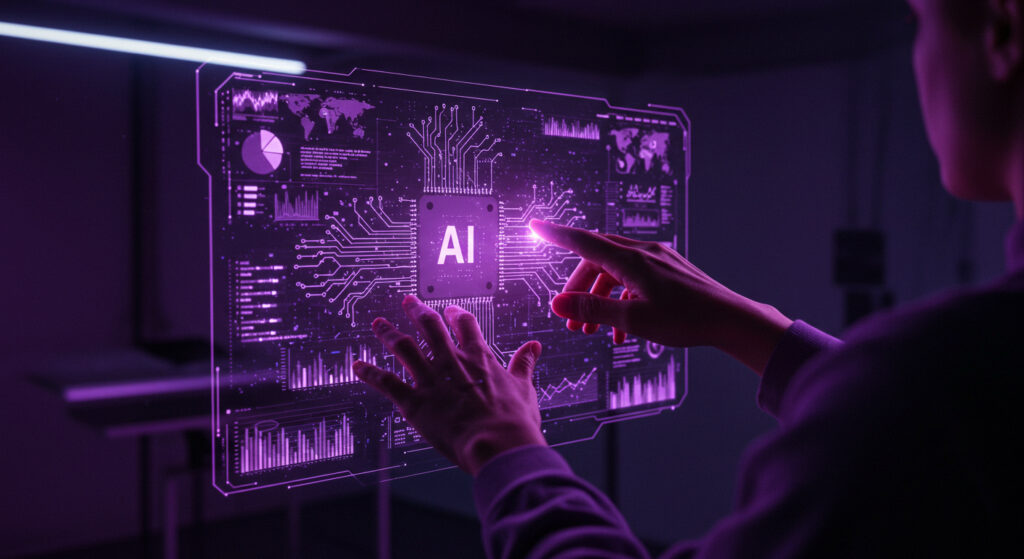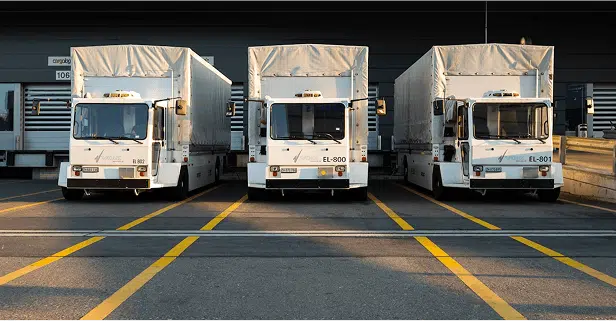The Rise of Spatial Computing:
How Businesses Can Leverage Immersive Experiences in 2025
In the rapidly evolving technological landscape of 2025, spatial computing has emerged as one of the most transformative innovations, fundamentally changing how we interact with digital information and experiences. No longer confined to the realm of science fiction or limited to niche applications, spatial computing is now a mainstream technology that’s reshaping industries and creating unprecedented opportunities for businesses willing to embrace its potential.
Spatial computing represents the next significant leap in human-computer interaction, moving beyond the two-dimensional constraints of traditional screens to create immersive, three-dimensional experiences that blend the digital and physical worlds. As we navigate through 2025, businesses across sectors are discovering that spatial computing isn’t just a technological novelty but a powerful tool that can drive engagement, efficiency, and innovation.
The convergence of advanced hardware, sophisticated software, and increasing consumer acceptance has created a perfect storm for spatial computing adoption. For forward-thinking organizations, the question is no longer whether to incorporate spatial computing into their strategy, but how to implement it effectively to gain competitive advantage in an increasingly digital marketplace.
What is Spatial Computing?
At its core, spatial computing refers to the technology that enables computers to understand and interact with the three-dimensional world around us. Unlike traditional computing interfaces that rely on screens and keyboards, spatial computing creates immersive experiences where digital content exists within and responds to our physical environment. This technology effectively bridges the gap between the digital and physical realms, allowing users to interact with digital information in a more natural and intuitive way.
Spatial computing encompasses a spectrum of technologies, including augmented reality (AR), virtual reality (VR), and mixed reality (MR). Augmented reality overlays digital information onto the real world, enhancing our perception of reality rather than replacing it. Virtual reality, on the other hand, creates fully immersive digital environments that transport users to entirely new worlds. Mixed reality, sometimes called hybrid reality, merges elements of both AR and VR, allowing digital and physical objects to coexist and interact in real-time.
What distinguishes spatial computing from earlier iterations of these technologies is its sophistication and seamless integration. Modern spatial computing systems can map physical spaces with remarkable accuracy, track user movements with precision, and render complex digital content that responds naturally to user interactions. The technology has evolved beyond simple visual overlays to incorporate advanced spatial audio, haptic feedback, and environmental understanding, creating truly immersive multi-sensory experiences.
The hardware powering spatial computing has also undergone significant evolution. In 2025, we’ve moved beyond bulky headsets and limited field-of-view displays to more elegant, lightweight devices with expanded capabilities. These advancements have made spatial computing more accessible and practical for everyday use, both in consumer and enterprise contexts.
Key Applications of Spatial Computing in 2025
As spatial computing technology has matured, its applications have expanded across numerous industries, transforming how businesses operate and engage with their customers. Here are some of the most impactful applications we’re seeing in 2025:
In retail and e-commerce, spatial computing has revolutionized the shopping experience. Virtual showrooms allow customers to explore products in three dimensions, visualizing items in their actual size and detail before making a purchase decision. Augmented reality try-before-you-buy experiences have become standard for categories ranging from furniture and home décor to fashion and accessories. Customers can now see how a sofa would look in their living room or how a pair of glasses would suit their face, all without leaving their homes. These capabilities have significantly reduced return rates while increasing customer satisfaction and conversion rates.
The manufacturing sector has embraced spatial computing for training, maintenance, and design visualization. Workers can now receive step-by-step guidance through complex assembly or maintenance procedures, with digital instructions overlaid directly onto the physical equipment they’re working with. Design teams use spatial computing to collaborate on three-dimensional prototypes, making adjustments in real-time regardless of their physical location. These applications have led to faster training cycles, reduced error rates, and more efficient design processes.
Healthcare has seen particularly transformative applications of spatial computing. Surgeons now routinely use spatial computing for surgical planning, visualizing complex procedures in three dimensions before making a single incision. Medical training has been enhanced through realistic simulations that allow students to practice procedures without risk to patients. Patient education has also benefited, with doctors using spatial computing to explain conditions and treatments in ways that patients can easily understand. These applications have improved surgical outcomes, accelerated learning, and enhanced patient comprehension.
In real estate and architecture, spatial computing has changed how properties are marketed and designed. Virtual property tours allow potential buyers or renters to explore spaces remotely, reducing the need for in-person visits and expanding the potential customer base. Architects and designers use spatial computing to create immersive visualizations of proposed buildings, allowing clients to experience spaces before they’re built and make more informed decisions about design elements.
Education and training across all sectors have been transformed by immersive learning environments. Students can now explore historical sites, conduct virtual science experiments, or practice specialized skills in safe, controlled environments. Corporate training programs use spatial computing to simulate complex scenarios, from emergency response to customer service interactions, allowing employees to gain practical experience without real-world consequences.
Implementation Challenges and Solutions
Despite its transformative potential, implementing spatial computing comes with several challenges that businesses must navigate. Understanding these challenges—and their solutions—is crucial for successful adoption.
Hardware limitations and costs remain significant considerations. While spatial computing devices have become more sophisticated and affordable, high-quality hardware still represents a substantial investment, particularly for large-scale deployments. Organizations can address this challenge through phased implementation approaches, starting with pilot programs in high-impact areas before expanding. Subscription and as-a-service models have also emerged, allowing businesses to access the latest hardware without massive upfront investments.
Content creation complexity presents another hurdle. Developing high-quality spatial computing experiences requires specialized skills in 3D modeling, interaction design, and spatial programming. This expertise is still relatively scarce in the job market. Forward-thinking companies are addressing this challenge by partnering with specialized development studios, investing in training for existing staff, and utilizing increasingly sophisticated content creation tools that simplify the development process.
Integration with existing systems can be particularly challenging, as spatial computing often needs to connect with enterprise data, customer information, and legacy applications. Successful implementations typically involve careful planning and the development of robust APIs and middleware solutions that bridge the gap between spatial computing platforms and existing IT infrastructure. Cloud-based solutions have emerged that facilitate this integration, allowing spatial computing applications to access and utilize enterprise data securely.
User adoption and learning curves cannot be overlooked. Even the most impressive spatial computing implementation will fail if users find it difficult or uncomfortable to use. Organizations are addressing this challenge through thoughtful onboarding processes, intuitive interface design, and gradual introduction of features. The most successful implementations focus on solving real user problems rather than showcasing technology for its own sake.
Business Benefits of Adopting Spatial Computing
The challenges of spatial computing implementation are outweighed by the substantial benefits it offers to businesses willing to make the investment. These benefits extend beyond novelty and technological advancement to deliver tangible business value.
Enhanced customer engagement and experiences represent one of the most immediate benefits. Spatial computing creates memorable, interactive experiences that capture attention in ways traditional media cannot. Businesses report higher engagement metrics, longer interaction times, and stronger emotional connections with brands that offer spatial computing experiences. These enhanced experiences translate directly to improved customer satisfaction, loyalty, and advocacy.
Improved operational efficiency emerges as spatial computing streamlines complex processes. In manufacturing, maintenance, and field service, spatial computing provides workers with precisely the information they need, when and where they need it. This contextual guidance reduces errors, accelerates task completion, and improves quality. Organizations implementing spatial computing for operational applications report productivity gains ranging from 25% to 40% for complex tasks.
Cost reduction in training and design has proven to be a significant benefit. Spatial computing enables realistic simulations that reduce or eliminate the need for physical prototypes, specialized training facilities, or travel for collaborative design work. Companies have reported training cost reductions of up to 50% while simultaneously improving knowledge retention and skill development. Design iterations that once took weeks can now be completed in days or even hours, accelerating time-to-market for new products.
Competitive advantage in the marketplace is perhaps the most strategic benefit. As consumers and business customers increasingly expect immersive, interactive experiences, companies that excel in spatial computing implementation distinguish themselves from competitors. This differentiation can be particularly valuable in crowded markets where traditional points of distinction have been eroded.
Data-driven insights from spatial analytics provide an often-overlooked benefit. Spatial computing systems can capture detailed information about how users interact with environments, products, and information in three-dimensional space. This data offers unprecedented insights into user behavior, preferences, and pain points, enabling continuous improvement of both the spatial computing experience itself and the products or services it showcases.
Future Outlook
Looking beyond 2025, the trajectory of spatial computing points toward even greater integration into our daily lives and business operations. Several key trends will shape this evolution.
The continued miniaturization and improvement of hardware will make spatial computing devices more comfortable, less obtrusive, and more powerful. We’re already seeing the early stages of this trend with lightweight glasses replacing bulky headsets for many applications. Eventually, spatial computing may move beyond dedicated devices entirely, integrating seamlessly into everyday objects and environments.
Standardization efforts across the industry will accelerate adoption by reducing fragmentation and compatibility issues. Open standards for content creation, data exchange, and interaction models will make it easier for businesses to develop spatial computing applications that work across multiple platforms and devices. This standardization will lower development costs and expand the potential audience for spatial computing experiences.
The role of 5G and edge computing in advancing spatial experiences cannot be overstated. These technologies provide the bandwidth, low latency, and distributed processing power necessary for complex, responsive spatial computing applications. As these networks continue to expand and evolve, they will enable increasingly sophisticated spatial computing experiences that can be delivered anywhere, anytime.
Artificial intelligence will become increasingly integrated with spatial computing, creating systems that can understand and respond to the physical world with greater autonomy and intelligence. AI-powered spatial computing will be able to recognize objects, understand contexts, and predict user needs, creating more natural and helpful experiences. This convergence of AI and spatial computing represents one of the most exciting frontiers in technology.
Conclusion
As we navigate through 2025, spatial computing stands at the forefront of technological innovation, offering businesses unprecedented opportunities to transform how they operate, engage with customers, and deliver value. The technology has matured beyond its experimental phase to become a practical, powerful tool for organizations across industries.
The businesses that will thrive in this new landscape are those that approach spatial computing strategically, focusing on applications that deliver genuine value rather than merely showcasing technology. Success requires understanding both the capabilities and limitations of current spatial computing technology, as well as having a clear vision for how it can address specific business challenges and opportunities.
For organizations that haven’t yet begun their spatial computing journey, now is the time to start exploring its potential. Begin by identifying high-impact use cases within your business, educating key stakeholders, and considering pilot projects that can demonstrate value while building organizational capability. The spatial computing revolution is well underway, and businesses that fail to adapt risk being left behind as competitors embrace this transformative technology.
Ready to Transform Your Business with Spatial Computing?
At 247Labs, we specialize in developing cutting-edge spatial computing solutions tailored to your specific business needs. Our team of experts combines deep technical knowledge with strategic business insight to create immersive experiences that drive real results.
Whether you’re looking to enhance customer engagement, streamline operations, or create entirely new product offerings, our comprehensive spatial computing services can help you navigate the complexities of implementation and maximize your return on investment.
Contact 247Labs today to schedule a consultation and discover how we can help you leverage the power of spatial computing to gain competitive advantage in today’s rapidly evolving digital landscape. Visit www.247labs.com or call us at 1-877-247-7421 to start your spatial computing journey.





